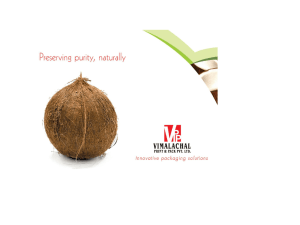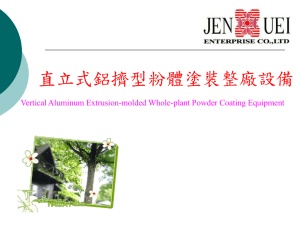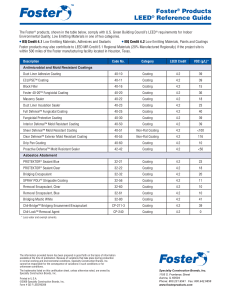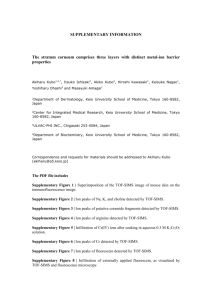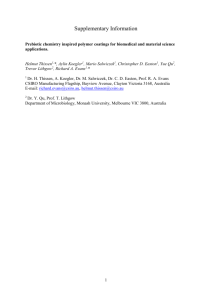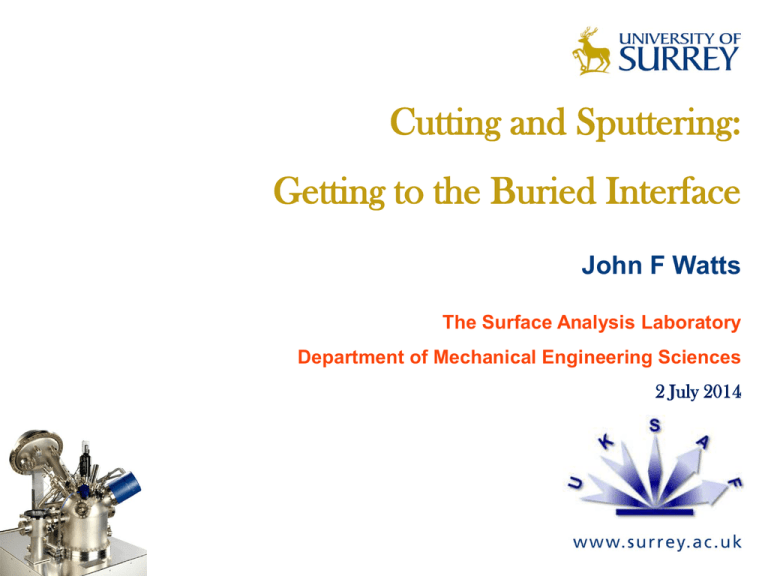
The Surface Analysis Laboratory
Cutting and Sputtering:
Getting to the Buried Interface
John F Watts
The Surface Analysis Laboratory
Department of Mechanical Engineering Sciences
2 July 2014
The Problem!
The Surface Analysis Laboratory
Inorganic Layers
The Surface Analysis Laboratory
J E Castle et al, Corr Sci, 16, 145-158, (1975)
High Temperature Oxidation
The Surface Analysis Laboratory
J C Rivière et al, Surf Sci, 117, 629, (1982)
R K Wild, Spectrochim Acta, 40B, 827, (1985)
Buried Interfaces: The Problem
The Surface Analysis Laboratory
10’s m - mm
d
Adhesive or Coating
Interface Region
100’s m - mm
Substrate
ARXPS d ~10nm
X-ray spectroscopies d ~200nm
RBS d ~1μm
One solution is mechanical sectioning of the
sample followed by analysis of the exposed
interfacial region
The Buried Interface
The Surface Analysis Laboratory
Obtaining analytical
information from intact
interfaces is very difficult.
Carrying out in-situ
experiments within the
spectrometer can be useful
but only rarely is the
interphase chemistry
exposed in this manner
J F Watts, Surf Interf Anal, 12, 497-503, (1988)
Oxide Stripping
The Surface Analysis Laboratory
Chemical removal of
metal substrate, depth
profiling of oxide in
situ by ion sputtering.
Interphase can then
be analysed directly
J F Watts, J E Castle, J Mat Sci, 18, 2987, (1983)
XPS Spectrum at Interphase
The Surface Analysis Laboratory
Fe(II)
Fe(II) satellite
Iron 2p3/2 spectrum
showing Fe(II)
component at
interface. Oxide is
entirely Fe(III).
Model of Interphase
The Surface Analysis Laboratory
Complementary Dissolution
The Surface Analysis Laboratory
Energy Filtered TEM
The Surface Analysis Laboratory
(a)
(b)
Energy-filtered (PEELS) TEM images of adhesively bonded aluminium
showing the interpenetration of organic and oxide phase that is achieved when
a primer is used (a). In the absence of a primer (b) the adhesive merely forms
a interfacial boundary with the oxide.
A J Kinloch, M Little, J F Watts, Acta Materialia, 48, 4543, (2000)
MICROM 355S
The Surface Analysis Laboratory
Ultra-Low Angle Microtomy
The Surface Analysis Laboratory
microtome blade
sample
angled
sectioning block
polyethylene
Angle Sectioning Block
12 x 12 x 7 mm3
+ 25 m = 0.03O
+ 50 m = 0.07O
+ 100 m = 0.15O
+ 200 m = 0.33O
ULAM Depth Profiling
The Surface Analysis Laboratory
Small area XPS analysis mode
(100 m)
Coating
q
Substrate
XPS
spot
size/m
ULAM taper angle/o
0.03
0.33
2.0
100
60
600
3500
15
13
100
500
Depth Resolution ULAM/nm
S J Hinder, C Lowe, J T Maxted, J F Watts, J Mater Sci, 40, 285, (2005)
ULAM/Small Area XPS
Depth Profile
The Surface Analysis Laboratory
80
70
Concentration / Atomic %
60
PVdF (topcoat)
Polyurethane (primer)
50
C1s
O1s
N1s x10
40
F1s
30
20
10
0
0
20
40
60
80
100
120
140
Depth / nm
S J Hinder, J F Watts, Surf Interf Anal, 36, 1032-1036, (2004).
160
ToF-SIMS of ULAM Interface
The Surface Analysis Laboratory
a)
+ve SIMS
b)
-ve SIMS
Polyurethane ions
c)
d)
2
(a)
m/z = 149: C8H5O3+
(b)
m./z = 26: CN-
(c)
m/z = 59: C3H4F+
(d)
m/z = 19: F250 nm
3
500 m
1
PVdF ions
S J Hinder, C Lowe, J T Maxted, J F Watts, Surf Interf Anal, 36, 1575, (2005)
Negative SIMS Spectra from
Images
a)
3500
The Surface Analysis Laboratory
25
3000
Point 2: Bulk Polyurethane
Counts
2500
2000
66
c)
41-42
49
1500
121
2
1000
100
500
0
c)
0
20
40
60
80
19
15000
100
120
140
160
180
200
1
13500
12000
Point 1: Bulk PVdF
10500
9000
Counts
3
m/z
7500
6000
39
4500
3000
49
85
1500
0
0
20
40
60
80
100
m/z
120
140
160
180
200
Reconstructed ToF-SIMS of
Interphase
b)
1400
19
Point 3: PU and PVdF at Interface
1200
1000
Counts
The Surface Analysis Laboratory
c)
85
800
2
600
31
400
71
55
87
200
121
141
3
185
1
0
0
20
40
60
80
100
m/z
120
140
160
180
200
ToF-SIMS of Acrylic Copolymer
Component of PVdF Topcoat
The Surface Analysis Laboratory
3000
31
2700
2400
71
41
2100
Counts
1800
85
1500
1200
900
x10
55
600
185
300
0
30
40
50
60
70
80
90
100
110
120
130
140
150
160
170
180
190
200
m/z
A negative ion ToF-SIMS mass spectra of the pure acrylic co-resin
component of the PVdF topcoat formulation in the mass range 30-200u
Retrospective Images of Acrylic
Ions
a)
The Surface Analysis Laboratory
b)
Negative Ion Mass
Selected Images
(a) m/z = 31: CH3Oc)
d)
(b) m/z = 55: C3H3O(c) m/z = 71: C3H3O2(d) m/z = 85: C4H5O2(e) m/z = 87: C4H7O2-
e)
f)
(f) m/z = 141: C9H13O4-
Model Specimen for ULAM
The Surface Analysis Laboratory
Adhesive
Interface
Adhesive/Aluminium/Adhesive
Adhesive
Aluminium foil
Line scan
used
M-L Abel, unpublished data (2008)
Adhesive
Polyamide Powder Coating +
Aminosilane addition
The Surface Analysis Laboratory
100 mm thick thermoplastic polyamide powder coating with
aminosilane added to the powder stock prior to spray coating
ULAM is carried out on the intact outer surface
to provide profile of air/coating interface and
delaminated coating interfacial failure surface to
provide steel/coating profile
M Guichenuy, J F Watts, M-L Abel, M Audenaert, Surf Interf Anal, 38, 168-171, (2006).
Aminosilane in PA11 Coating
The Surface Analysis Laboratory
3
4
2.5
Atomic %
1.5
2
1
1
0.5
0
//
0
0
1
2
Depth / m
Air/Coating Interface
3
92
94
96
98
100
Depth / μm
Coating/Steel Interface
100 m thick polyamide powder coating with aminosilane added to
the powder stock prior to spray coating
Atomic %
3
2
Thin Film Solution
10’s m - mm
d
The Surface Analysis Laboratory
Adhesive or Coating
Interface Region
100’s m - mm
Substrate
Deposit a very thin layer of organic phase
This may be from the plateau region of an adsorption isotherm
Prepare specimen at monolayer coverage (i.e.
plateau region) for XPS or ToF-SIMS analysis
It is then possible to probe interface chemistry
directly
Organosilane Adhesion Promoters
The Surface Analysis Laboratory
Molecular Dynamics Models of:
(a) Epoxy
(b) Amino
(c) Vinyl
ToF-SIMS to Identify Specific
Interactions
The Surface Analysis Laboratory
The intense SiOAl+
peak is indicative of a
covalent bond between
the aluminium oxide
and the organosilane
adhesion promoter
Conclusions
The Surface Analysis Laboratory
A variety of “mechanical” and chemical methods
to approach interfaces
ULAM provides an easy way to section samples
at very low angles which has the potential to
provide chemical depth profiles at very high
depth resolution when used in conjunction with
a surface analysis method such as XPS or ToFSIMS
Polymer/polymer systems are straightforward, if
the candidate substrate is metal a thin foil must
be used
Thermosetting systems can be cut at ambient
temperature, thermoplastic systems may need a
cold stage





